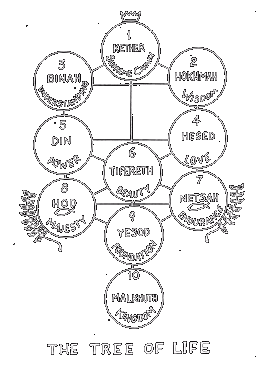IN THE COURT OF THE CRIMSON KING
- chapter index -
pg. 1 - Epitaph | pg. 2 - The Iron Gates of Fate
pg. 3 - The Fate of All Mankind | pg. 4 - Moonchild
pg. 5 - The Court of the Crimson King | pg. 6 - The Purple Piper
pg. 7 - Averroes | pg. 8 - The Keeper of the City Keys
pg. 9 - The Pilgrim's Door | pg. 10 - The Return of the Fire Witch
pg. 11 - The Gardener Plants An Evergreen | pg. 12 - The Prism Ship
pg. 13 - The Grinding Wheel | pg. 14 - On Soft Gray Mornings
pg. 15 - Divining Signs | pg. 16 - The Yellow Jester
pg. 17 - Remember the Future | pg. 18 - The Return of the King
pg. 19 - The I Ching | pg. 20 - Octants
- page index -
The Book of Illumination
site index
Translate from
" I chase the wind of a prism ship
To taste the sweet and sour. "
The obvious interpretation is that this passage expresses the narrator's desire to experience new perspectives. But the word "prism" is also a Kabbalistic reference.
The Prism Ship

|
"According to ancient Kabbalists, reality is composed of 10 dimensions. The
Kabbalist refers to these 10 dimensions as Ten Sephiroth, meaning ́ten
emanationsî of Light.
The structure of the 10 Sephiroth acts as a prism that refracts the Light into various frequencies giving rise to the diversity that composes the entire spectrum of creation." - Sephiroth "In the language of earlier Kabbalistic writers the sephiroth represented ten primeval emanations of God, ten focii through which the energy of a hidden, absolute and unknown Godhead (En Soph) propagated throughout the creation, like white light passing through a prism. The sephiroth can be interpreted as aspects of God, as states of consciousness, or as nodes akin to the Chakras in the occult anatomy of a human being." The ultimate nature of God is neither known nor manifest to us." Sometimes God Hides "but just as light can be passed through a prism to produce a rainbow of colours, so God manifests in the creation as ten divine lights or emanations, usually referred to as sephiroth." - Kabbalah by Colin Low |






















 Arachnophilia
Arachnophilia